Events:
November 1-2: Florida Chapter of The Wildlife Society Fall Meeting
November 2-4: Florida Ornithological Society Fall Meeting
November 3: Basic Shorebird ID at Gambel Rogers Memorial State Recreation Area
November 7: Siesta Key Shorebirds
November 8: Shorebird Walk at Mantanzas Inlet
November 10: Birds of the Beach at Rookery Bay
November 11: Shorebirds of Talbot Island State Parks
November 18: Shorebirds of Florida's West Coast
Hurricane Michael
On October 10th Hurricane Michael slammed into the Florida panhandle just shy of a Category 5 storm. It was the strongest storm on record in the panhandle and the third-most intense, in barometric pressure, Atlantic hurricane to make landfall in the contiguous US. The wake of destruction shattered buildings, destroyed cities, and most importantly indelibly transformed the lives of many people.
Many of our panhandle FSA partners live in the direct path of the hurricane. Their lives are forever altered and the baseline for "normal" has drastically shifted. For some of our partners it will take months and years to rebuild. Despite facing insurmountable odds, our conservation community came together to demonstrate incredible resilience and support for each other.
In the immediate aftermath, partners got their chainsaws out and conducted safety checks on our conservation community. In one instance, one of our long-term supporters was trapped in his house for three days before being helped by our chainsaw-wielding partners. In another instance, when a long-term monitoring partner didn't communicate after the storm, our community activated a dauntless effort to reach her until we knew she was safe. These are just a couple of stories of how we show up for each other in times of trouble.
In every instance, our people exemplified what it means to move beyond partnership mode and into community support. For those whose loss is unimaginable, you are in our thoughts and hearts. Recovery of the panhandle is going to take years. Yet, even in these initial stages of recovery, our partners are already monitoring the impacts to shorebirds and their habitats across the panhandle. Your dedication to each other and Florida's shorebirds is unparalleled.
If you would like to contribute to recovery efforts for those impacted by Hurricane Michael, view a list of vetted options here.
(Cover photo: in the aftermath of Hurricane Michael, large flocks of roosting seabirds were seen on southwest Florida beaches. Photo courtesy of Jean Hall)
 Partner Spotlight: Barbara Eells of the Florida Panhandle Shorebird Working Group
Barbara Eells is one of the few people in the Florida panhandle who remembers when shorebirds successfully nested on beaches that are now developed. In fact, she began monitoring breeding snowy plovers and developed concerns about habitat loss before they were on FWC’s radar in the panhandle region. Over the years, she grew to understand the monitoring and management needs for coastal shorebirds and continues to tirelessly dedicate her time to their protection.
Barbara has monitored breeding and non-breeding shorebirds in the Florida panhandle as a fish and wildlife volunteer for decades. She typically covers beaches in Bay and Gulf counties, encompassing approximately 20 miles of habitat. At any of these routes, Barbara can be found with a hammer pounding posts, her scope for re-sighting banded birds, filling in holes left by beach visitors, or in her vehicle keeping an eye on an incubating plover.
If you ask Barbara about “her shorebirds”, she will provide you with the history of the area and the history of many of the banded plovers that occur in the area. One story includes a male snowy plover, she affectionately refers to as the ‘Old Man’, who was banded by an FWC biologist in 2004. Barbara has kept an eye on him and his many chicks for the last 15 years. The Old Man is fortunate to have Barbara on site to provide him with the protection efforts needed to enable him to successfully fledge young each season.
Barbara’s interest in coastal conservation is not limited to shorebirds. She also coordinates, recruits and trains volunteers for sea turtle surveys at coastal areas like Mexico Beach and St. Joe Beach. Barbara ensures that sea turtle volunteers are not only aware of shorebird concerns, but are able to recognize focal species, monitor plover broods, re-sight banded individuals, and provide outreach and education. Although her efforts have slowed down in recent years, she also provides wildlife rehabilitation for the Gulf County area. She not only cares for injured wildlife but provided a permanent home for wildlife that could not be released back into the wild, including a Black Vulture named Vultch.
As a retired school teacher, education and outreach come natural to Barbara, particularly when the subject involves coastal wildlife. Accordingly, she conducts outreach at the local Port St. Joe High School to educate local youth about coastal habitats, wildlife and conservation concerns. Many of the animals that were part of the rehabilitation center participated in outreach events at local festivals or at special events at local state parks. She is also affectionately referred to as the ‘bird lady’ at many of the nesting beaches she monitors because she does not shy away from educating beach visitors or informing them of the rules in place to protect wildlife. Over the years, Barbara also worked with the local home owner’s association to change coastal management practices such as beach raking to reduce disturbance to shorebirds. She's also worked with county staff or land managers to ensure that development at known nesting sites included protection for shorebirds. Barbara’s local involvement for the protection of wildlife could fill a novel.
Barbara and all her efforts highlight the importance of volunteerism and the critical role that volunteers play in wildlife conservation. Barbara not only inspires tomorrow’s conservationist, including many of the FWC and Audubon biologists that regularly work with her in the panhandle, but reminds us that it requires a community effort to move the conservation needle for shorebirds and other coastal wildlife. Lastly, Barbara demonstrates that shorebird conservation is possible, and with dedication we can protect and preserve shorebird habitat for future generations. The Florida Shorebird Alliance is stronger because of Barbara and we are eternally grateful for her countless efforts to conserve shorebirds!
|
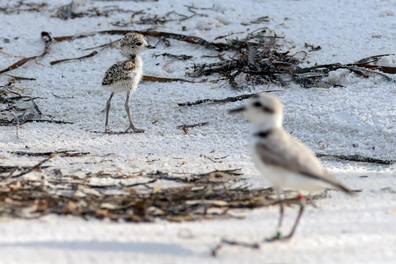 |
Barbara's "Old Man" snowy plover and his chick from the 2018 breeding season.
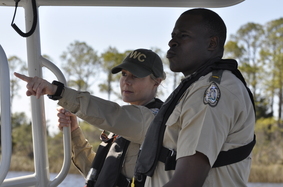 FWC Law Enforcement Increases Shorebird Patrols
As we all know, human disturbance at nesting areas can result in severe impacts to shorebirds and seabirds. For example, in Volusia County in 2014, a couple with 5 dogs landed on Disappearing Island and entered a posted least tern colony. The disturbance event was reported by Michael Brothers, Manager of the Marine Science Center. He was observing the island from the mainland with a scope when he saw the disturbance in progress. By the time law enforcement was able to respond, the damage had been done. By the next day, only 6 of 67 nests remained in the posted area, and those birds soon abandoned nesting as well.
Local partnership stewarding efforts continue to grow and are essential to reducing disturbance at nesting areas. Now, FWC law enforcement is also increasing patrols of shorebird, seabird, and wading bird nesting areas, including Critical Wildlife Areas. Shorebird patrols are also being tracked in FWC’s Computer Aided Dispatch (CAD) system. The goals of this new effort are to have officers conduct patrols to: 1) respond to any violations in progress, and 2) stop disturbance before it happens by educating members of the public visiting important nesting areas. “The mere presence of officers at some of our colonies can reduce disturbance significantly,” said Jean Rolke of Audubon FL.
FWC’s Northeast Region was the first region to expand proactive shorebird patrols. This year, over 300 patrols were conducted at shorebird, seabird, wading bird and CWA sites totaling over 400 patrol hours. “We discussed this issue with our FWC biologists and other shorebird partners and realized we could make a real difference by expanding patrols,” said FWC NE Regional Commander Jay Russel.
Close coordination with FWC shorebird biologists throughout the nesting season is essential to the success of these efforts. Jean Olbert, NE Regional Shorebird Biologist said, “FWC law enforcement has many responsibilities, so it’s important to help prioritize which sites are the most crucial for patrols. Shorebird monitoring by FSA partners informs us of which sites are the highest priority at a given time during the nesting season.”
Based on the success of the program in Northeast Florida, shorebird patrols will continue to be expanded to other parts of the state. The FSA sends a BIG thank you to all law enforcement officers for helping protect our imperiled shorebirds and seabirds!
|

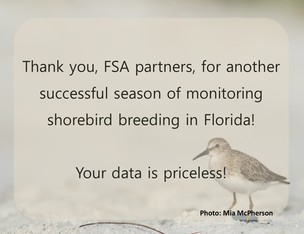 FSA Partners Complete Another Season of Successful Breeding Monitoring
With the arrival of November, the 2018 breeding season is in the rear view mirror for most of our partners. For the Florida Shorebird Database crew, however, data quality control, summaries, and analyses remain in the foreground. Monitoring shorebird and seabird populations is a fundamental strategy for conservation success across the state. Your efforts directly impact the viability of shorebirds and seabirds. Here is a snapshot of the 2018 effort:
In 2018, 211 partners entered data and visited 406 rooftops a total of 4,237 times. You also surveyed 330 routes, covering 893.57 miles of Florida coastline.
A HUGE thank you to everyone who monitored this year. The FSD may be closed but it’s not too late to send in your data! If you monitored this year but didn’t get around to entering your data into the FSD, just email FLShorebirdDatabase@myFWC.com and we will help you get the data into the database. Remember, every bit of data helps advance shorebird conservation. All surveys are valuable, whether or not they occurred during a count window. If you have any data to share, please let us know!
|
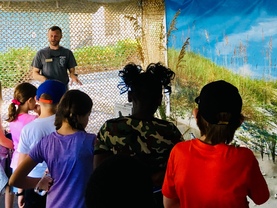 Marine Quest Success!
Marine Quest is the largest outreach event for the FWC Florida Wildlife Research Institute in St. Pete. The open house event is an opportunity for the public to tour Institute laboratories and learn about ongoing research. In 2018, the event reached more than 7,000 people in a span of three days. This year, the FSA research crew decided to rebuild the shorebird display to attract more attention to Florida's beach nesting birds and our monitoring network.
The new and improved display was a huge success! Kids and adults alike were thrilled to try to find cryptic nests on the life-size beach scene. Countless thoughtful questions were asked about beach-nesting shorebirds and the FSA saw an increase in newsletter subscribers and Facebook membership.
Thank you to the dedicated team of researchers that built a top-notch display. If you didn't make it to Marine Quest this year, stay tuned for next year's event to be held in October.
|
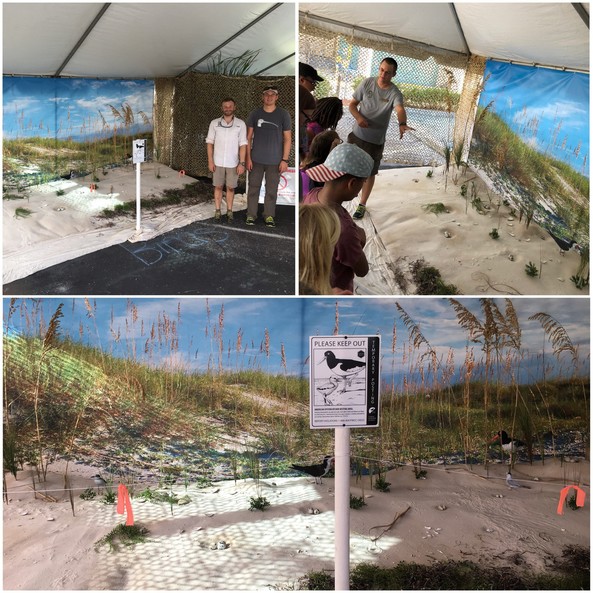 Top left: Joe Marchionno and Ezra Thompson - the geniuses who redesigned and built the shorebird display for 2018 Marine Quest. Top right: Ezra is educating school kids about ground colonies. Bottom is an up close look at the life-sized display. Above: Joe teaches kids about the importance of the wrack found on beaches.
|